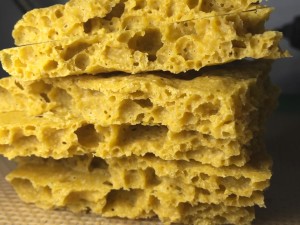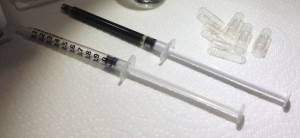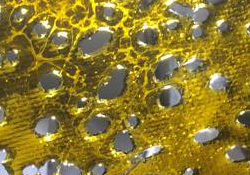In the previous post, “What the Heck is a Dab?”, I didn’t want to get too heavy into what concentrates are exactly, so here is the next post I promised for you cannabis medicine newbies. Concentrates are made utilizing a few different kinds of extraction methods that separate some of the most useful parts of the cannabis plant from the plant material itself. There are solvent extractions meaning solvents like alcohol and butane, used to flush off the useful parts and then the solvents are removed entirely by evaporation or pressurized purging. It sounds awful, but done correctly these methods pose no health risk. You would be surprised how many items you may consume everyday that have had chemical exposure through processing, like bleached white flour and decaffeinated coffee.
Some plants can be steam distilled to extract their goodies, but cannabis isn’t one of them, because cannabinoids are not water soluble. Just like the wonderful and hugely expensive rose oil absolute, extraction of the most important cannabis plant parts requires a solvent to pull the cannabinoids and terpenes out of the plant, and what’s left after the solvents have been removed is a very concentrated oily tar like substance that can then be further refined.

BHO – Butane Hash Oil, aka butane honey oil because it has a look and consistency of honey. Consistency and color varies from barely golden to dark, dark green. Butane must be thoroughly purged, and that’s why it is important to get “lab tested” product that has been checked for solvents. Since butane is extremely flammable, this is better left to the experts or you may just blow up your house or apartment complex. BHO can be smoked, vaped or used to made edibles, tinctures, canna caps and topicals. It may also be further refined using extreme temperatures and specialized equipment to create products like shatter and wax. Consumers should always demand lab tested BHO products.
CO2 Extraction – Same as above, but made with safer CO2 instead of butane. The equipment to make this is very expensive, but because it is so safe to make and consume it is becoming concentrate of choice. The equipment is soooo expensive that cost is usually bore by the end consumer, making it pretty darn expensive medicine. This method can also be further refined.

Wax – aka ear wax, and although that sounds disgusting, it is only a descriptive name as to the consistency. It can be made from BHO or CO2 extractions. It is easier to use when vaping or smoking because it isn’t as sticky as BHO. It is made by whipping air into the oil when it is getting purged. Wax is sold at dispensaries usually by the gram and can be crumbly, an oily paste, or like a cookie with air bubbles, (often called honeycomb).
Shatter – Is like BHO, but different steps are taken in the process. Finished, it can be like taffy or so solid it snaps when you break into it. It is usually a clear amber color, but color can vary from pale golden or almost green to dark amber. Shatter can be made from butane extracted or CO2 extracted.

Live Resin – This is becoming the top of the line for concentrates, and I haven’t seen it in dispensaries yet. This is probably because it is made differently than the others. Live Resin is made from a freshly harvested live plant, that is immediately frozen at very, very low temperature before extraction. While crazy do-it-yourself people can create the other concentrates, at their own risk, (dangerous and explosive!) at home, Live Resin is made with a closed-loop-system for extraction – that expensive equipment I mentioned earlier, , causing the price to be quite a bit higher. The process creates a terpene-rich concentrate that is both very flavorful and very potent because there is nothing lost in the curing/drying process. It looks similar to shatter. The other methods require the plant matter to be completely dry, no moisture, before extraction, and with that process there is always a loss of medicinal benefit.

Hash, or hashish – When the cannabis plant is handled and processed, be it at the producer or in one’s own home, the tiny trichomes that hold aroma and flavors as well as the medicinal cannabinoids, will fall off the plant. They can be collected along the way and this is called kief. Some folks use small hand grinders to break up their buds for vaping or smoking, and some of these grinders have a false bottom with a silk like screen that will filter the kief into a bottom container. Hash is just ultra compressed kiev with minute bits of plant matter. it can be smoked in a pipe, sprinkled in a joint, or used in edibles. There are other ways to extract kief from plants and a common way is using ice in the plant matter to make the trichomes so brittle they fall off, filtered through screens and are collected at the end of the line.

Although it’s not smoked, lastly I need to mention FECO (full-extract cannabis oil, aka RSO (Rick Simpson oil), aka Buddha’s Tears. Used orally in canna caps or just a rice grain sized smeared on a piece of bread and swallowed. It is made by soaking the plant material in a solvent like grain alcohol (or moonshine-like everclear) to rinse the trichomes off the plant. Then the plant matter is removed, the liquid is filtered and then the alcohol is evaporated off with low heat. The result is a very dark green tar-like substance that is difficult to deal with, so it is best stored in a syringe (minus the needle, like a child’s oral medicine syringe. These are best kept in the fridge if not being used up in 30 days or so. There are some cold, quick rinse methods that produce a lighter colored oil that lacks the chlorophyll and other plant constituents, but the yield is less and it isn’t really that much better a medicine, in my opinion. You can make FECO at home if you have a lot of plant matter, but alcohol is flammable too, so it must be done in a well ventilated area. There are numerous tutorials all over the internet.
There is CannaGramma’s crash course of cannabis concentrates. In my next post I will cover how to use these products.
![]() Photos provided by Herbal Edibles, Albuquerque, NM
Photos provided by Herbal Edibles, Albuquerque, NM

Well if you’re Weiner dog is anything like mine was. About half what you’d use for yourself. She was a good damn Stoner.
Hello, I have Buddha’s tears, but not sure how much to give my senior dog, wiener dog, 13 years old, about 20-25 lbs.
Thank you
I don’t know what you are using it for, so I can’t really say. If you have a facebook account, there is a group called Phoenix Tears and they have the answer, I’m betting. https://www.facebook.com/groups/474089696057739/